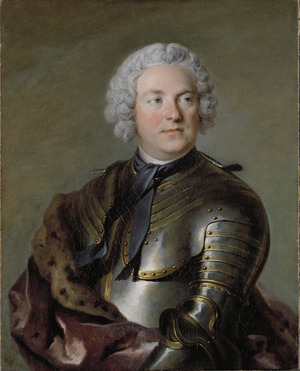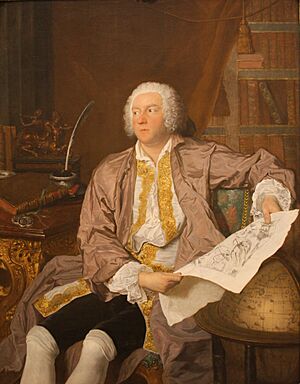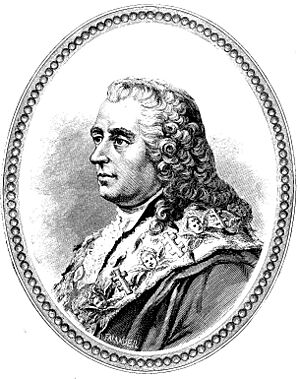Carl Gustaf Tessin facts for kids
Quick facts for kids
Carl Gustaf Tessin
|
|
|---|---|

Portrait of Count Tessin by Louis Tocqué, 1741
|
|
| Born | 5 September 1695 Stockholm, Sweden |
| Died | 7 January 1770 (aged 74) Åkerö Manor, Sweden |
| Nationality | Swedish |
| Spouse(s) | Ulrika Sparre |
| Father | Nicodemus Tessin the Younger |
| Mother | Hedvig Eleonora Stenbock |
| Occupation | diplomat, art collector |
Count Carl Gustaf Tessin (born September 5, 1695 – died January 7, 1770) was an important Swedish Count and politician. He was the son of the famous architect Nicodemus Tessin the Younger and Hedvig Eleonora Stenbock. Carl Gustaf was known as a very smart person and a great speaker. He also helped bring a lot of French culture to Sweden.
Carl Gustaf Tessin started his public career in 1723. People quickly noticed his excellent speaking skills and his talent for diplomacy. In 1725, he became an ambassador to Vienna. When he returned, he became very important in the Riksdag of the Estates, which was like Sweden's parliament.
From 1739 to 1742, Tessin served as ambassador to France. He was very good at improving the relationship between France and Sweden. During his time in Versailles, Carl Gustaf Tessin supported many artists and musicians. When he came back to Stockholm, he continued to build one of Sweden's largest art collections. This collection, along with the king's, became the start of the Nationalmuseum in Sweden.
Carl Gustaf Tessin passed away at his country home, Åkerö Manor, in 1770. He made many important contributions to Swedish culture throughout his life.
Contents
Carl Gustaf Tessin's Early Life
Carl Gustaf Tessin was born in Stockholm, Sweden. His father was a very important royal architect. His father's family were city dwellers, while his mother came from a noble family. In 1727, Carl Gustaf married Ulrika Sparre.
He began his public career in 1723. At that time, he was part of a group that supported the young Duke Carl Frederick of Holstein. This group wanted him to become the next king of Sweden. In 1725, Tessin became the ambassador in Vienna. In this role, he worked against plans for Sweden to join an alliance that was against Russia.
A Career in Diplomacy and Politics
During the riksdag meetings in 1726–27 and 1731, Tessin strongly disagreed with the government. His cleverness, great speaking skills, and strong presence made him a leader of a political group called "The Hats". From 1735 to 1736, he was again the Swedish ambassador in Vienna.
During the riksdag of 1738, he was chosen as the marshal of the Riksdag of the Estates. He played a big part in changing the government that year. He then chose to become the special ambassador in Paris. From 1739 to 1742, he impressed everyone at Versailles with his charm. He also helped bring back the old alliance between France and Sweden.

Tessin's political skills were very strong. He helped the "Hats" party get out of a difficult situation after a war with Russia in 1741–42. He was rewarded with a seat in the senate for his services. In 1743, Tessin tried to solve long-standing disagreements between Sweden and Denmark during a special trip to Copenhagen.
In 1744, he led a special group to Berlin. Their job was to bring Frederick the Great's sister, Louisa Ulrika, to Stockholm. She was going to marry the Swedish crown prince, Adolphus Frederick. Tessin quickly became a favorite of the royal couple. He also helped the crown prince become more independent from the influence of the Russian Empress Elizabeth. This helped Sweden stay independent.
Helping the Royal Family
Carl Gustaf Tessin became a member of the Royal Swedish Academy of Sciences in 1741. From 1746 to 1752, Tessin was the president of the chancellery, which was like being the prime minister of Sweden. He wanted Sweden to become closer to Denmark. This was to balance the power of Russia in the north.
However, his plan to connect the two royal families through marriage upset the Swedish crown prince. The prince, who was from Holstein, strongly disliked anything Danish. Also, when Adolphus Frederick became king of Sweden in 1751, Tessin did not support giving the king more power. Because of this, his relationship with the royal court ended.
In 1752, he stepped down as prime minister. In 1754, he also stopped being the governor for the young crown prince Gustavus. He spent the rest of his life at his estate, Åkerö Manor, where he passed away.
His Amazing Art Collection
Carl Gustaf Tessin was also a passionate art collector. During his time as ambassador in Paris, he bought many paintings and drawings. This included 2000 drawings from a famous auction in 1741. When he returned to Sweden, he owed a lot of money. Because of this, he had to sell part of his collection to King Fredrik I. The king then gave these artworks to Queen Louisa Ulrika. Today, a large part of his art collection is in the Swedish Nationalmuseum.
Some of his collection was even shown in New York at the Morgan Library & Museum. The exhibition was called "Treasures from the Nationalmuseum of Sweden: The Collections of Count Tessin."
Carl Gustaf Tessin's Writings
Carl Gustaf Tessin also wrote several important works:
- Tessin och Tessiniana (first published in Stockholm, 1819): This book contains parts of Tessin's own detailed Memoirs, which were 29 volumes long.
- K. G. Tessins Dagbok (Stockholm, 1824): More parts from his Memoirs.
- En gammal mans bref til en ung Prins (Stockholm, 1753): This book was a series of letters written to his student, who later became Gustavus III.
Images for kids





